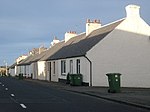Alva, Clackmannanshire
Alva, ClackmannanshireHillfoots VillagesParishes in ClackmannanshireTowns in Clackmannanshire

Alva (Scottish Gaelic: Ailbheach, meaning rocky) is a small town in Clackmannanshire, set in the Central Lowlands of Scotland. It is one of a number of towns situated immediately to the south of the Ochil Hills, collectively referred to as the Hillfoots Villages or simply The Hillfoots. It is located between Tillicoultry and Menstrie. Alva had a resident population of 5,181 at the 2001 census but this has since been revised to 4,600 in 2016. It boasts many features such as a park with an event hall and a newly opened outdoor gym, and is the home of Alva Academy.
Excerpt from the Wikipedia article Alva, Clackmannanshire (License: CC BY-SA 3.0, Authors, Images).Alva, Clackmannanshire
Stirling Street,
Geographical coordinates (GPS) Address Nearby Places Show on map
Geographical coordinates (GPS)
| Latitude | Longitude |
|---|---|
| N 56.153048 ° | E -3.799565 ° |
Address
Stirling Street
Stirling Street
FK12 5EG
Scotland, United Kingdom
Open on Google Maps






